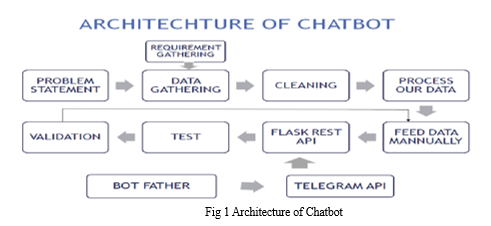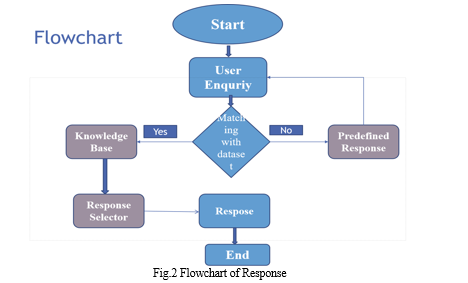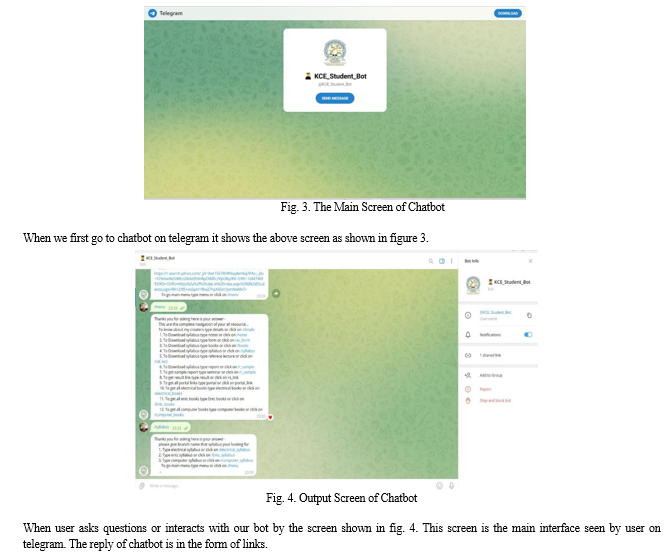Ijraset Journal For Research in Applied Science and Engineering Technology
- Home / Ijraset
- On This Page
- Abstract
- Introduction
- Conclusion
- References
- Copyright
A Real Time Chatbot Using Python
Authors: Prof. Vaishali Sarode, Bhakti Joshi, Tejaswini Savakare, Harshada Warule
DOI Link: https://doi.org/10.22214/ijraset.2023.53453
Certificate: View Certificate
Abstract
Real-time chatbots developed using Python have emerged as powerful tools for enhancing customer support, improving user experiences, and streamlining business processes. Leveraging Python\'s extensive libraries and frameworks, such as NLTK, Flask, and telebot, developers can build intelligent and scalable chatbot systems.This paper provides an overview of the key components and techniques involved in developing a real-time chatbot using Python. It explores the process of requirement gathering, use case definition, conversation flow design, and performance optimization. Integration with backend services, error handling, validation, and user experience (UX) design are also discussed. The utilization of natural language understanding (NLU) algorithms and techniques allows chatbots to interpret and comprehend user intents, providing accurate and context-aware responses. Integration with REST APIs, Flask, and telebot facilitates seamless communication and interaction between the chatbot and users. Furthermore, the paper highlights the importance of security, privacy, and ethical considerations in chatbot systems. It emphasizes the significance of continuous testing, feedback iteration, and user-centric design principles to refine the chatbot\'s performance and enhance the user experience. Looking ahead, future work in real-time chatbot development using Python includes advancements in natural language processing (NLP), personalized user experiences, multi-modal capabilities, and the integration of voice assistants. Ethical considerations and explainable AI techniques will also be critical for building trustworthy and responsible chatbot systems. In conclusion, real-time chatbots developed using Python offer immense potential for transforming customer support, automating processes, and delivering personalized and efficient services. With ongoing advancements in NLP, AI, and user interface design, the future of real-time chatbots holds exciting possibilities for enhanced user interactions and seamless automation.
Introduction
I. INTRODUCTION
“Digitalization, the surge of mobile and internet connected devices has revolutionized the way people interact with one another and communicate with business”. Millennials are accepting and supporting new technology into the routine of their everyday life, this is becoming more prevalent as technology companies are streamlining Artificial Intelligence (AI) into the product they offer, such as; Google Assistant, Google Home and Amazon Alexa.
Many companies offer the 24×7 customer care services which are usually done by chat bots which simulates the human like chats with customers helping them in usual problems they face by using algorithm to check the most asked questions by people.
Our project is a chat bot which is designed for educational purpose. Now a days many students use mobile phones. It is an integrate part of people’s life. Our project is a chat bot which is designed for educational purpose for student. This bot provides single platform for the different problems regarding to students. This chat bot is available anywhere at any time and it can consult problems and doubts of students. It provides latest, convenient and reliable information to students. It provides answer material in form of links to that pdf or any other format.
II. NEED FOR PROJECT
Now-a-days the world is changing drastically, development in IT and electronics field and innumerous research in field of science led to the new technologies to develop every day. So, to keep up with drastically changing technologies the universities usually update the syllabus of technical studies. Usually, the changes in study pattern and syllabus are more often in field of science.
These frequent changes in syllabus led to the confusion among students about what to study or even what is our correct syllabus. This also sometimes led to unavailability of standard study materials. Due to this, students refer bulky reference books in which they find few topics of syllabus in one and other in another. So usually, students prefer searching for study materials on internet and searches through multiple sites and sometimes they are confused about what is genuine and what is not.
Even that many students have fill-up many types of forms during their academics and errors in those forms can be the reasons of losing opportunities in carrier. Students need a guidance for form filling such as scholarship, university admission, university exams, competitive exams, courses, etc. Even about carrier choices, competitive exams etc.Students also requires information such as paper pattern, previous year question papers, etc.
III. LITERATURE SURVEY
There are several researches and development in field of Artificial Intelligence (AI) and rapid expansion digital networks has made communication more convenient and hence increased the need of quick as well as all time available services. Chatbot is one of the popular and highly expanding way of service providers. Here are few researches which we have referred to understand and design our project.
- Shreyashkar Sharma (July 2020) describes the different steps of chatbot implementation this chatbot using python programming language. The chatbot can be implemented in three ways. First of it is pattern matching, this is the first developed method in history of chatbot and it uses the method of comparing words given by the user to recognize the intention and provide relevant output. Second method is Natural Language Understanding (NLU), in this method it uses the speech or text sent by user and converts it to computer understandable data it’s called as natural language processing.
- Jaimit Dholakia (April 2020) explains in detail about how he used python programming and worked with flask API. His research was the guide and inspiration for using FLASK framework in our project. Flask API works as a connector for this different applications and programs used in our project.
- Kshitija Shingte, Anuja Chaudhari, Aditee Patil, Anushree Chaudhari, Sharmishta Desai (June 2021) has elaborated about how they have designed the chatbot for educational pourpose. Even though this chatbot was designed for same profession i.e. educational field but there was a slight difference in pourpose of designing. It was a good guide for knowing how one can design a chatbot.
- Ujjwal Kumar, Murai Jha, Sonam Sirohi, (May 2022) have done the research on using telegram platform for chatbot which can work in text as well as has text-to-speech facility. It describes the process of developing a bot on telegram. Some advance topics which we may work in future are discussed like text-to-speech conversion.
- Teddy Surya Gunawan, Asaad Balla Falelmula Babiker, Nanang Ismail, Mufid Ridlo Effendi (January 2022) they have done research and development on designing a chatbot on telegram using Natural language processing (NLP).
IV. ARCHITECTURE
The chatbot is a student help desk which is available at any time, it is designed on the basis of intellectually independent model. This type of chatbot takes the feedback from client for its queries. Our project is designed on the Telegram platform as it’s GUI. This chatbot is built by using different platforms. Fig1. Shows he architecture our project. The given architecture can be divided into Telegram Platform (GUI) (this is the way by which users will interact with or bot), Data Set (which is available on cloud which has intended responses), and last is REST API which work as bridge between our NLP algorithm designed in python, Data set and telegram API.

- Problem statement: It is the initial cause of making this bot. It is the issues faced by students to get the relevant study material and information.
- Requirement Gathering and Data Gathering: This includes the notes, reference books, syllabus, office desk information, etc. as well as the list of phrases of replies that our bot will use to communicate with user. On the basis of the fields of problem domain as well as the data required, we create the table of replies for our bot.
- Cleaning and Data Processing: In this step we divide our collected Data into Main Dialog and Predefined responses. These main dialogs are further categorized into entities and may have further sub divisions. Were, Predefined responses are categorized as greetings and feedback or enquiry.
- Manual Data Feeding: The raw data or information to be provided by Admin can be in form of pdf, links to web page or even images in any case; these are converted into link format by admin and provide manually to categorized data set. This data is updated time to time by admin, this is to ensure that bot provides latest information to user.
- Flask Rest API: Flask is a framework provided by python, it works as bridge between these different platforms. The rest API provides the data from our knowledge base in usable URL format. Our bot is providing the study material in form of links which directly opens the pdfs in the cloud which user can download. Providing data in form of links helps in giving quick response as it requires less data usage to transfer over the internet.[1]
- Telegram API and Bot Father: Telegram API is an interface provided by Telegram for using programs for auto replies to in our account. Bot father is a service provided by telegram which identifies and manages all bots over telegram platform. It tokenizes the user bot to authenticate and provide end to end encryption for security of bot.
- Test and Validation: Testing of bot is required to check the proper functioning of it. We have tested our codes by giving the various cases as a user and observe it’s responses.
Working Of Chatbot On Basis Of Response Based On User Input
As disscussed earlier our bot gives two types of responses to user they are predefined response and main dialog. The response is created from main dialog when user inquires for the defined entiry which is available in our knowledge base. Were as when user enquires with greetings or with something which is not understandable to bot it gives predefined reponse as feedback.

When user gives the text to chatbot it fragments these sentences into words. Then it checks for the grammer or spelling mistakes and guess the intended words by user. It identifies the keyword or entity from the sentences. These entities are checked in the knowledge base and if there are more than one responses to be generated for this entity then it asks for the feedback to get more prcise inforamation about what user is asking for. If the identified words are greetings like “Hello” or “Hii”or else then it gives predefined greeting response. But if the user gives any readom word which are not understandable to bot then it gives predefined response for not understanding the intentions of user.
V. RESULT AND DISCUSSION
The Chatbot developed for the students was initially planned to design using Google service called Dialog Flow. This service makes it easier for designing the robust dialog charts for chatbot. Hence, it is easier for designing the replies for bot. But as this service is paid service we decided to use telegram as it is open source. These are the result of our bot.

Conclusion
In conclusion, real-time chatbots developed using Python offer numerous benefits and possibilities for various applications. They provide instant assistance and support to users, enhance customer experiences, and improve operational efficiency. Python\'s rich ecosystem of libraries and frameworks, such as NLTK, Flask, and telebot, enables developers to build intelligent and scalable chatbot systems. Throughout the development process, various components and techniques are involved. These include natural language understanding (NLU), backend service integration, error handling, validation, and user experience (UX) design. The use of REST APIs, Flask, and telebot facilitates seamless communication and interaction between the chatbot and users. Key considerations in real-time chatbot development include requirement gathering, use case definition, conversation flow design, and performance optimization. The integration of machine learning, natural language processing (NLP), and AI techniques further enhances the chatbot\'s capabilities, enabling it to understand user intents, personalize responses, and continuously learn and improve. Ensuring security, privacy, and ethical considerations is vital in chatbot systems, and user feedback and testing play a crucial role in refining the chatbot\'s performance and user experience. Overall, real-time chatbots developed using Python have the potential to transform customer support, streamline processes, and provide personalized and efficient services. As advancements in NLP, AI, and user interface design continue, the future of real-time chatbots holds even more exciting possibilities for enhanced user interactions and seamless automation.
References
[1] Jimit Dholakia , “Creating RESTful Web APIs using Flask and Python”, Published in (Towards Data Science) Apr 26, 2020 [2] Shreyaskar Sharma, “Chatbot Development Using Python”, Published in International journal of Creative Research Thoughts (IJCRT), July 7th, 2020. [3] Kshitija Shingte, Anuja Chaudhari, Aditee Patil, Anushree Chaudhari, Sharmishta Desai, “Chatbot Development for Educational Institute”, Published in SSRN, June 6th 2021. [4] Ujjwal Kumar, Murai Jha, Sonam Sirohi, “Smart Telegram Chatbot”, Published in Journal of Emerging Technologies and Innovative Research, vol. 9, May 2022. [5] Teddy Surya Gunawan, Asaad Balla Falelmula Babiker, Nanang Ismail, Mufid Ridlo Effendi, “Development of Intelligent Telegram Chatbot Using Natural Language Processing”, Published on IEEE, January 18th 2022.
Copyright
Copyright © 2023 Prof. Vaishali Sarode, Bhakti Joshi, Tejaswini Savakare, Harshada Warule. This is an open access article distributed under the Creative Commons Attribution License, which permits unrestricted use, distribution, and reproduction in any medium, provided the original work is properly cited.

Download Paper
Paper Id : IJRASET53453
Publish Date : 2023-05-31
ISSN : 2321-9653
Publisher Name : IJRASET
DOI Link : Click Here
 Submit Paper Online
Submit Paper Online

